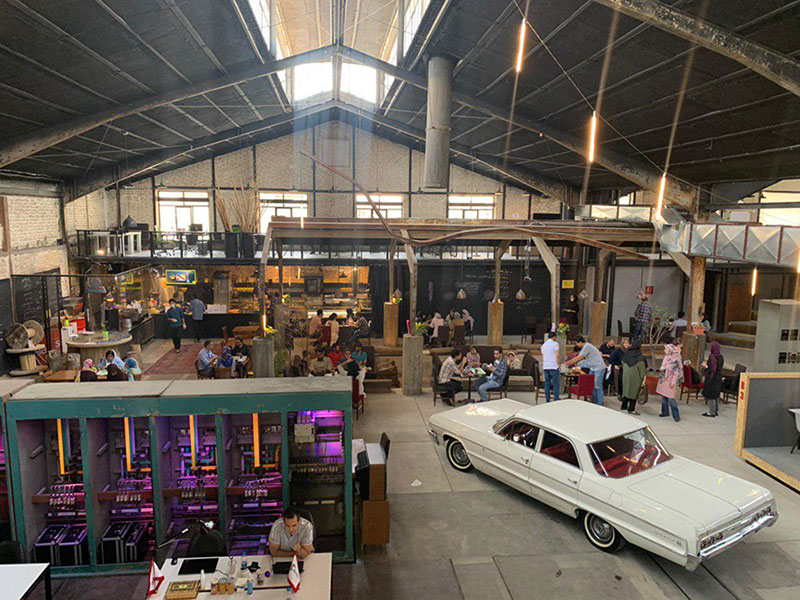
An Investor’s Deep Dive into Iran’s Coworking Spaces
This analytical report offers global investors, founders, and researchers a detailed examination of Iran’s shared workspace sector, drawing exclusively upon proprietary operational and statistical data collected by the Spash platform.
Table of Contents
ToggleExecutive Summary
The Iranian shared workspace market is characterized by rapid recent expansion, having more than doubled in size between 1402 and 1404 (2023–2025), rising from 50 to 120 official spaces. The Spash platform currently covers 70 active complexes, representing approximately 58% of the total official market. Key metrics include 13,000 registered reservations and 4,290 unique users. Investment attractiveness is driven by significant unmet demand, particularly in West Tehran, a recognized demand hotspot, and the progressive shift towards private offices, which now account for up to 80% of space allocation in some complexes. The market is highly technical, with developers constituting the majority of active users. Monthly rentals generate 80% to 90% of primary revenue, yielding 6 to 8 million Tomans per seat in Tehran. This data is exclusive to the Spash platform.
The Spash platform serves as a critical technological backbone for Iran’s shared workspace sector. The core value proposition of the Spash platform is rooted in operational efficiency and cost reduction: on average, it has been able to reduce the managerial and executive workload of internal staff at each workspace by the equivalent of 1.5 person-hours or 1.5 human resources. By automating repetitive tasks such as reservation logging, invoicing, and financial follow-up, Spash helps managers address the critical challenge of controlling overhead costs and maximizing utilization. This automation capability is essential for increasing profitability and ensuring long-term stability in a market where complex management needs often focus on attracting new users and controlling current operations.
Quantitative Overview
The shared workspace industry in Iran has recently emerged from its expansion and maturity phase (1399 to 1402). Following the COVID-19 pandemic and increased demand for flexible work, the industry experienced a significant jump. The number of registered coworking spaces surged from 50 spaces in 1402 (approximately 2023) to 120 spaces in 1404 (approximately 2025), representing more than twofold growth over a two-year period.
Demand for these spaces is supported by several macro-factors, including government support for knowledge-based companies, the growth in commercial real estate rental prices steering businesses toward cost-effective models, and the shift among companies establishing remote workforces.
A progressive and significant trend observed since the beginning of 2025 is the increased demand for Private Offices compared to shared desks, mirroring a global shift. Consequently, many complexes are now dedicating up to 80% of their area to private offices to meet this need.
Macro-Statistics (Based on Spash Platform Coverage)
| Metric | Count/Figure | Details/Context |
| Total Official Spaces (Iran) | 120 | Total registered market size (as of 1404). |
| Spash Market Coverage | 70 complexes (approx. 58%) | Active complexes on the platform. |
| Y-o-Y Growth (1402–1404) | More than twofold | Increase from 50 spaces to 120 spaces. |
| Total Registered Reservations | 13,000 | Historical reservation count on the platform. |
| Total Users | 4,290 | Total active users registered. |
| Primary User Segment | Developers/Programmers | Programmers constitute 10.72% of total users (460 out of 4292). |
| Tehran Monthly Seat Revenue | 6 to 8 million Tomans | Primary revenue stream for spaces. |
| Average Space Size (Tehran) | 500 to 1000 sqm | Can reach up to 2000 sqm in larger complexes. |
| Average Length of Stay | 2 to 3 months | Average user utilization period. |
Geographic Distribution of Active Complexes
Tehran remains the primary center for shared workspaces, accounting for one-third of the country’s total spaces. Mashhad is identified as a high-potential and growing secondary market.
| City/Province | Active Complexes (on Spash) | Market Role |
| Tehran | 30 | Main Hub of shared workspaces. |
| Mashhad | 6 | Growing market with high potential. |
| Other Provinces | Limited number | Includes Ardabil, Kermanshah, Karaj, Bandar Abbas, Isfahan, and Sari, generally reporting a lower number of reservations. |
Comparative Analysis of Key Players
To understand the diversity and strategic positioning within the Iranian coworking sector, an analysis of key complexes active on the Spash platform reveals distinct strategies concerning specialization, scale, and location. This analysis compares seven strategically distinct spaces: Haft-o-Hasht, Zavieh, Finnova, Enerjik, Kara Health, Metre Moraba, and Edareh Man.

Pricing & Value Analysis
Actual cost-per-desk data is not provided, but the sources indicate typical revenue streams, allowing for a value-based analysis. Tehran spaces generate 6 to 8 million Tomans per monthly seat, while spaces in other cities yield 4 to 6 million Tomans. Value correlation suggests that complexes providing specialized access or unique environments are positioned to command the higher end of this revenue spectrum.
- Specialization as Value Driver: Finnova, with its acceleration and investment (VC) approach, FinTech lab, and consulting services, offers a high-value proposition that goes beyond mere rental. Similarly, Kara Health Accelerator offers specialized support for HealthTech startups. These offerings justify a potentially higher price point by substituting consulting or accelerator fees for standard rental fees, aligning with the global trend of shifting revenue from pure rental to Value-Added Services (VAS).
- Infrastructure and Location Premium: Zavieh emphasizes professional and team-oriented design, strong infrastructure, and an acoustic environment, catering to teams willing to pay a premium for high-quality operational stability and team focus. Metre Moraba in Mashhad derives its value from an Excellent Commercial Location within a large commercial complex, suggesting convenience and ancillary facilities (side facilities) are the primary value metrics, likely supporting the higher end of the 4–6 million Toman Mashhad revenue bracket.
- Cost-Effectiveness/Basic Service: While specific pricing for Rubik in Sari is not included in the primary comparison group, it is explicitly noted for its cost-effective pricing. This suggests that spaces in provincial cities lacking strong specialization often compete on price, driving down the regional revenue per seat.
Tehran Coworking Spaces
| Space Name | Address | Capacity | Unique Feature |
| Haft-o-Hasht | Branch 1: Azadi Innovation Factory, Sould Haft-o-Hasht, Tehran / Branch 2: Iran Mall, South West side, G1 floor, Tehran | 40 daily seats, Private Offices, and dedicated desks in both spaces | Focus on construction and technique, innovation workshop space, flexibility, and networking within Azadi Factory |
| Zavieh | Tehran: Azadi Innovation Factory / Zahedan: Science and Technology Park / Shiraz: Fars Science and Technology Park / Qazvin: Sa’d al-Saltaneh Caravansary | 40 daily spaces, monthly spaces, private offices, and meeting rooms | Professional and team-oriented design, acoustic environment, strengthening team spirit, and strong infrastructure |
| Finnova | Vanak Square, Allameh Tabataba’i University Growth Center, Tehran | Meeting room, 100 daily and monthly seats | Accelerator and Investment (VC): First coworking space with an acceleration and investment approach, FinTech lab, and consulting services |
| Enerjik | Amirkabir University of Technology, Faculty of Petroleum Engineering, Tehran | Meeting room, silence room, 60 daily and monthly seats | University Space: Access to university resources and presence within Amirkabir University |
| Kara Health Accelerator | Azadi Square, Lashkari Expressway, Tehran | 36 daily seats, meeting room, monthly seats, and private offices | Health Sector Specialization: Support and acceleration for HealthTech startups |
| We Can | Branch 1: Pasdaran Street, Tehran / Branch 2: Alborz Innovation Factory | Meeting room, daily seats, and private offices | Local access for Alborz Factory personnel and East Tehran residents |
Mashhad Coworking Spaces
| Space Name | Address | Capacity | Unique Feature |
| Coworking Space 24 | Rahnamayi Street, between Rahnamayi 15 and Salman Tower, Mashhad | Currently full | 24-hour space and welfare services |
| Metre Moraba (Square Meter) | Kian Center 1, Third Floor, Intersection of Janbaz and Framarz Blvd., Mashhad | 8 daily seats, monthly spaces updated monthly | Excellent Commercial Location: Situated in a large commercial complex with side facilities and easy access |
| Edareh Man (My Office) | Hashemiyeh Street, Mashhad | Currently offers only daily spaces | Support for Women: Coworking space with a supportive and business development approach for women entrepreneurs and professionals |
| Havash | Sajjad 21, Nabsh Amin Sharghi 2, Mashhad | 20 daily seats and 10 monthly seats | Flexibility and Dynamic Community: Offering diverse programs, focus on networking and acceleration |
| Caspian | Seyed Razi 48, Mashhad | 20 to 30 rentable seats | Welfare services and accessibility |
Other Coworking Spaces
| Space Name | Location | Address | Capacity | Unique Feature |
| Karinja | Ardabil | Milad Freeway, Ardabil | Meeting room, dedicated desks, and 7 monthly private work desks | First Local Coworking Space: Providing basic services for freelancers and small teams in the provincial capital |
| Rubik | Sari | 18th Dey Street, Sari, Mazandaran | Meeting room, monthly seats and offices, 10 daily seats | High-speed internet, good city atmosphere in Sari, cost-effective pricing |
Target Audience/Specialization
The market demonstrates a clear split between generalized community spaces (catering to the overall dominant segment of developers) and highly verticalized niches.
- Vertical Specialization: Complexes demonstrate specialization based on sector or demographic:
- HealthTech: Kara Health Accelerator.
- Financial/FinTech: Finnova (FinTech lab, acceleration/investment) and Planet (Financial sector focus).
- Fashion/Textile: Khaneh Maan (Our House).
- Construction/Technique: Haft-o-Hasht, which also features an innovation workshop.
- Gender-Specific: Edareh Man (My Office) in Mashhad specifically supports women entrepreneurs and professionals, focusing on business development within a specialized demographic.
- Infrastructure/Ecosystem Specialization:
- University-Access: Enerjik’s location within Amirkabir University of Technology provides users with unique access to university resources.
- Team/Corporate: Zavieh emphasizes strengthening team spirit and acoustic environments, targeting established teams or corporates seeking a professional, high-infrastructure environment.
Scale & Infrastructure
Coworking spaces in Tehran typically range from 500 to 1000 square meters, but larger spaces can reach up to 2000 square meters. The analysis reveals a strategic advantage dichotomy between “factory” (large-scale) and “niche” (boutique/highly focused) sizes.
- The “Factory” Model (High Capacity/High Integration): Spaces like Finnova (100 seats) and those integrated into innovation factories like Haft-o-Hasht (40 daily seats plus private offices in the Azadi Innovation Factory) leverage scale for high-volume networking and resource pooling. The strategic advantage here is the density of community and ecosystem integration, essential for acceleration and large-scale networking, as seen in Haft-o-Hasht’s focus on flexibility and networking.
- The “Niche” Model (Boutique Capacity/High Focus): Complexes like Kara Health (36 seats) and Metre Moraba (8 daily seats) operate at smaller capacities. Their strategic advantage is hyper-focus and curated community. For Kara Health, the small scale likely supports intensive acceleration, while Metre Moraba sacrifices capacity for an excellent commercial location and convenience. This allows the spaces to build specific culture and community—one of the key management challenges faced across the sector.
Geographic Strategy
The geographic strategy determines both accessibility and market implication, often correlating with target audience.
- Innovation Factory Hubs (Tech Hub Strategy): Several key Tehran spaces are strategically located within the Azadi Innovation Factory (Haft-o-Hasht, Zavieh). This strategy implies targeting startups and developers directly within the established technical ecosystem, leveraging the factory’s existing reputation and user flow. This location type attracts the dominant technical user profile.
- Decentralized/Local Access Strategy (CBD vs. Residential):
- CBD/High Traffic: Finnova (Vanak Square) and Metre Moraba (Janbaz/Framarz Blvd., Mashhad) choose high-profile commercial locations, prioritizing central business district access and associated amenities.
- University Integration: Enerjik’s location inside Amirkabir University is a highly specific decentralized strategy focused solely on the academic/research community.
- Suburban/Local: We Can operates branches in Pasdaran (East Tehran) and Alborz Innovation Factory, specifically aiming for local access for East Tehran residents or Alborz Factory personnel.
- Provincial Expansion Strategy: Zavieh employs a multi-city strategy, establishing presences in Tehran, Zahedan, Shiraz, and Qazvin, often within Science and Technology Parks (STPs) or historical locations (Sa’d al-Saltaneh Caravansary). This indicates a commitment to scaling professional infrastructure across different regional ecosystems. Furthermore, the observation that West Tehran is a “hot spot” suggests that current user demand favors locations closer to emerging tech and residential areas over traditionally central business districts.
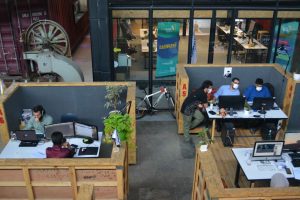
For Investors
Identify Promising Profiles:
Investors should prioritize models demonstrating hyper-specialization integrated with value-added services (VAS), as this aligns with global revenue trends and the high-value end of the Tehran market (6-8 million Tomans/month).
- Acceleration Models: Finnova (VC/FinTech lab) and Kara Health (HealthTech) represent attractive profiles because they serve as gateways to specific vertical sectors and generate revenue through service fees (acceleration/consulting) beyond mere rental income.
- Decentralized Multi-Hub Operations: Models like Paradise Hub (cited as having potential for growth with multiple urban spaces) or Zavieh (multi-city presence) are resilient, catering to diverse needs and mitigating risks associated with single-location reliance.
- High-Demand Factory Integration: Haft-o-Hasht, as the most popular workspace and integrated into the Azadi Innovation Factory, signals high-liquidity operations supported by continuous networking and innovation demands.
Investment Gaps (Premium vs. Affordable):
- Premium Private Offices (Immediate Gap): The overwhelming shift toward Private Offices (80% allocation) indicates a severe lack of high-quality, scalable private space tailored for scaling teams (the primary users are often technical staff/CEOs). Investment is needed to retrofit existing complexes or establish new ones focusing explicitly on premium, flexible Private Office inventory, especially in high-demand areas like West Tehran.
- Second-Tier Market Infrastructure: Mashhad is identified as a growing market with high potential. While spaces like Metre Moraba leverage commercial location, there is an opportunity to invest in standardized, high-infrastructure models (similar to Zavieh’s focus on acoustic and team environment) in Mashhad and other high-potential provinces (e.g., Isfahan, Karaj) to capitalize on the lower operating costs (4–6 million Tomans/seat) and emerging regional demand.
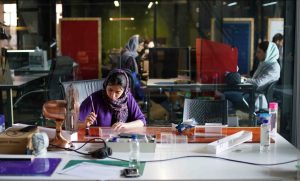
For Founders
Recommend Best-Value/Community Spaces for Specific Startup Types:
Founders should select spaces where the community focus directly supports their business model, maximizing the value derived from acceleration and networking services rather than just desk rental.
- Fintech Startups: Finnova is the clear recommendation due to its unique value proposition as the first coworking space with an acceleration and investment approach, alongside a dedicated FinTech lab and consulting services. This offers direct access to capital and sector expertise.
- SaaS/General Tech (Developers, Web Designers, SEO): Founders focused on broad technical applications should target high-demand hubs like Haft-o-Hasht, particularly those integrated into innovation factories (Azadi). The focus on construction/technique and strong networking capabilities supports the primary demographic of programmers and entrepreneurs (top users). For teams prioritizing professionalism and strong operational stability, Zavieh (with its emphasis on acoustic environment and team spirit) is ideal.
- E-commerce/Niche Consumer (Fashion, Health): Startups in vertical consumer markets must choose highly specialized accelerators. Khaneh Maan (Fashion and textile sector) or Kara Health Accelerator provide the necessary domain-specific support and community that are unavailable in generalized hubs.
For Researchers
What do trends suggest about the broader Iranian startup/freelance economy?
The analysis of city growth, amenity popularity, and user profiles provides strong indicators regarding the sophistication and structural characteristics of the Iranian technical workforce and entrepreneurial ecosystem.
- Maturity of the Technical Workforce: The dominance of Programmers (10.72%) and Developers (majority of active users) confirms that the engine of the Iranian startup economy is deeply technical and product-focused. This workforce drives high demand, justifying the need for high-speed internet (a key feature noted for spaces like Rubik) and sophisticated infrastructure (Zavieh).
- Ecosystem Formalization and Scaling: The progressive shift in demand toward Private Offices and the presence of prominent residents like Digikala startup teams suggest that the startup sector is moving past the early-stage, hot-desk phase. Companies are formalizing, seeking privacy for intellectual property, and requiring flexible, yet dedicated, team spaces. This trend signifies a maturing ecosystem where successful companies are scaling internally rather than remaining entirely freelance.
- Decentralization and Regional Potential: The recognition of Mashhad as a growing market with high potential and the documented presences in cities like Ardabil, Shiraz, and Zahedan indicate that entrepreneurial activity and the freelance economy are successfully decentralizing beyond Tehran. This is supported by initiatives like Karinja, which provides basic services for freelancers and small teams in provincial capitals.
- Value Transition: The push by space managers to focus on community building and providing benefits beyond simple desk rental suggests that the Iranian market is evolving from a commodity rental service to a relationship and ecosystem facilitator, mirroring international trends (where pure rental revenue is declining). This indicates a growing awareness of the cultural and networking demands crucial for long-term member retention.
| Position | Count | Percentage of Total |
| Programmer | 460 | 10.72% |
| Entrepreneur | 273 | 6.36% |
| Graphic Designer | 248 | 5.78% |
| Project Manager | 188 | 4.38% |
| CEO (Chief Executive Officer) | 172 | 4.01% |
| Web Designer | 140 | 3.26% |
| Freelancer | 139 | 3.24% |
| Employee | 120 | 2.79% |
| SEO Specialist | 116 | 2.70% |
| UI/UX Designer | 100 | 2.33% |
| Content Creator | 98 | 2.28% |
| Digital Marketing | 86 | 2.01% |
| Student | 82 | 1.91% |
| Consultant | 65 | 1.52% |
| Web Developer | 61 | 1.42% |
| Teacher/Instructor | 55 | 1.28% |
| Software Engineer | 52 | 1.21% |
| Photographer | 50 | 1.17% |
| Support | 47 | 1.10% |
| Sales Manager | 45 | 1.05% |
| (Other Occupations) | 1877 | 43.74% |
| Total | 4292 | 100.00% |
High-Demand Occupations: Information on the top 5 occupations in terms of bookings is available for some spaces.
| Position | Count | Percentage |
| Programmer | 85 | 42.7% |
| CEO (Chief Executive Officer) | 35 | 17.6% |
| Web Developer | 29 | 14.6% |
| Entrepreneur | 26 | 13.1% |
| Architect | 24 | 12.1% |
Conclusion & Declaration
The Iranian coworking market presents compelling opportunities rooted in high organic growth and structural shifts. Key opportunities exist in catering to the rising demand for premium Private Offices in established hotspots like West Tehran and replicating successful, infrastructure-focused models in high-potential secondary markets such as Mashhad. The market is supported by a large technical workforce and is moving toward vertical specialization (FinTech, HealthTech), providing clear entry points for targeted investment.
Challenges remain significant, including the need to sustainably attract and retain members, increase revenue beyond base rental, and successfully foster community building amidst increasing competition. Overcoming these requires leveraging technology (like the Spash platform’s automation features to reduce overhead) and evolving business models to offer comprehensive ecosystems, as demonstrated by the potential growth of multi-space models like Paradise Hub. The sector acts as a vital Gateway to the Iranian Market for international companies seeking access to the country’s skilled technical workforce at competitive operational costs.
This entire analysis and the insights generated are derived from proprietary data provided by the Spash platform.
—————————————————————————————————————————
Frequently Asked Questions (FAQ)
- How quickly is the Iranian market for best coworking spaces iran growing?
The Iranian shared workspace market has undergone significant expansion, rising from 50 registered spaces in 1402 to 120 spaces in 1404, representing more than twofold growth over a two-year period. Currently, the Spash platform covers 70 active complexes, which accounts for approximately 58% of the total official market. The most popular complex, based on reservation rates on the Spash platform, is Haft-o-Hasht.
- What are the most active and best coworking spaces in tehran?
Tehran is recognized as the main hub of shared workspaces in the country, hosting 30 active complexes on the platform. Prominent spaces in iran coworking tehran include Haft-o-Hasht and Zavieh, both strategically located within the Azadi Innovation Factory. Finnova (Vanak Square) is another key player, known for being the first space with an acceleration and investment (VC) approach, alongside a dedicated FinTech lab. User demand suggests that West Tehran is currently a hot spot for new investment and user demand.
- What is the typical cost structure for coworking spaces iran for rent?
The primary revenue stream for coworking spaces comes from monthly rentals, accounting for 80% to 90% of the primary revenue. The average revenue generated per monthly seat varies geographically: in Tehran, it ranges from 6 to 8 million Tomans, while in other cities, it is slightly lower, ranging from 4 to 6 million Tomans.
- Are there specialized coworking space tehran options for specific technical sectors?
Yes, the market demonstrates a growing trend toward specialization. Several complexes cater to specific niches:
- Finnova: Focuses on the Financial and FinTech sector, offering acceleration, investment, and consulting services.
- Kara Health Accelerator: Provides support and acceleration specifically for HealthTech startups.
- Planet: Concentrates on the Financial sector.
- Haft-o-Hasht: Focuses on construction and technique, featuring an innovation workshop.
- What are the key market trends regarding space allocation in iran coworking tehran?
A significant progressive trend since the start of 2025 is the increased demand for Private Offices compared to shared desks. This shift has led many spaces to allocate up to 80% of their area to private offices to accommodate the needs of scaling teams and companies.
- Beyond the capital, what is the status of regional expansion, particularly regarding coworking space isfahan?
Tehran accounts for one-third of all coworking spaces in the country. Mashhad is the leading secondary market, identified as a growing region with high potential, hosting 6 active complexes. Other provinces, including Isfahan, Ardabil, Kermanshah, Karaj, Bandar Abbas, and Sari, currently have a limited number of active complexes and consequently report a lower volume of reservations. Spaces like Karinja in Ardabil provide basic services for freelancers and small teams in provincial capitals.
- Who are the main users of shared workspaces in Iran?
The dominant user profile across the sector is technical. Developers (or programmers) constitute the majority of active users. Programmers account for 10.72% of all registered users on the Spash platform (460 out of 4292). Other high-demand occupations include entrepreneurs, graphic designers, project managers, and CEOs.

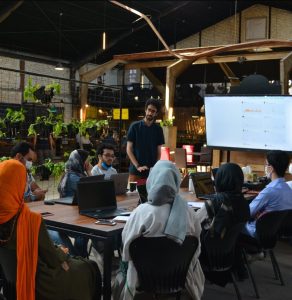





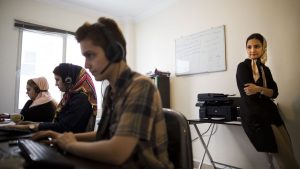





Post Comment